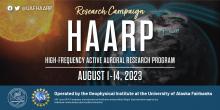Polar Aeronomy and Radio Science Summer School returns to HAARP
Polar Aeronomy and Radio Science Summer School returns to HAARP

More than 50 researchers will be in Alaska in August for the resumption of a science summer school that culminates with experiments at the High-frequency Active Aurora Research Program facility operated by the University of Alaska Fairbanks Geophysical Institute.
The Polar Aeronomy and Radio Science Summer School was last held more than 10 years ago. Its return is provided for as part of a five-year $9.3 million National Science Foundation grant awarded to UAF in 2021. That funding allowed creation of the Subauroral Geophysical Observatory for Space Physics and Radio Science at HAARP. - Rod Boyce, University of Alaska Fairbanks Geophysical Institute
“The return of PARS marks a milestone for HAARP and the geospace communities,” HAARP Director Jessica Matthews said. “With a strong foundation laid during previous PARS events from 2000 to 2012, PARS 2023 is committed to meeting the growing demand for skilled scientists and engineers with knowledge of the special effects that occur in the ionosphere at high latitudes.”
The program runs Aug. 1-14. Participants will spend the first few days in classes and experiment design at the Geophysical Institute, have two full days of recreation in Valdez and then spend several days at HAARP in Gakona, Alaska, to run their experiments. Details on the experiments (the Final Transmission Notice) are available on our Google group, https://groups.google.com/g/hamsci/c/8c2-UNIc3T4
PARS participants experience the complete scientific process, from background research to experiment design and execution and, finally, to results and analysis.
Researchers, including faculty and students, from the following institutions will attend: University of Alaska Fairbanks, Air Force Institute of Technology, Auburn University, Georgia Institute of Technology, Los Alamos National Lab, University of Colorado Boulder, University of Colorado Denver, University of Florida, University of Houston, University of New Brunswick, Virginia Tech, Naval Research Laboratory, Cornell University, International Institute for Astronautical Sciences and Canada Council for the Arts.
The PARS campaign has over 30 experiments dealing with such diverse topics as very low frequency radio wave generation, detection of irregularities in Earth's ionosphere, ocean remote sensing, atmospheric remote sensing and space debris detection.
And there’s one experiment that is of an artistic nature.
“Ghosts in the Airglow” by Canadian artist Amanda Dawn Christie is a transmission art project through HAARP that mixes audio and images from the transition between Earth’s atmosphere and outer space. Shortwave radio listeners from around the world are invited to tune in and submit reception reports online through the project’s website.
The 2021 National Science Foundation grant provides funding for observatory operations, for financial support for travel and time at the facility for scientists, and for education and community outreach. Research is initially expected to include the study of various types of aurora and other occurrences in the ionosphere, which stretches from about 50 miles to 400 miles above the Earth’s surface.
The UAF Geophysical Institute operates HAARP under an agreement with the Air Force. In August 2015, the Air Force transferred the research equipment to UAF under an Education Partnership Agreement.
